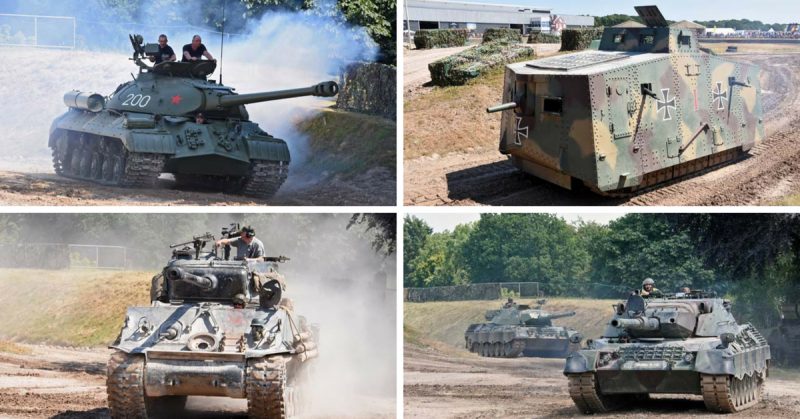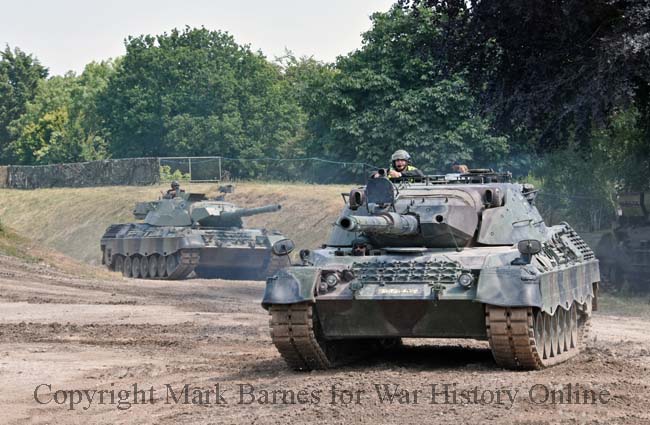
Friday is now heralded as rehearsal day with a limited program in the arena. It was possible to have a choice of spots to snap from on the bank in front of the museum used by the vast majority of spectators on the two show days.
The area set aside for the media is the fenced off section seen in the background of this photograph of the museum’s two Leopard 1 tanks going through their routine. The Leopards, one ex-Bundeswehr, the other Canadian; are used to open the show with a supercharged race around to blow cobwebs from visitors only just sorting out their day at Bovington.
Getting the choreography right is not as straightforward as we might assume and a third tank had to go in for hasty repairs that were completed in time for the main event.
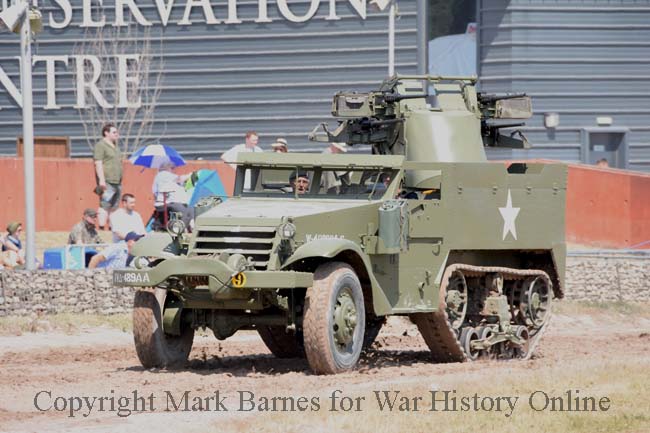
This M16 half-track fitted with a quad .50 calibre anti-aircraft gun has only recently been repainted. The event announcer alluded to the fact the jury is out whether the correct color shade has been used. My personal opinion is the color is a bit on the light side.
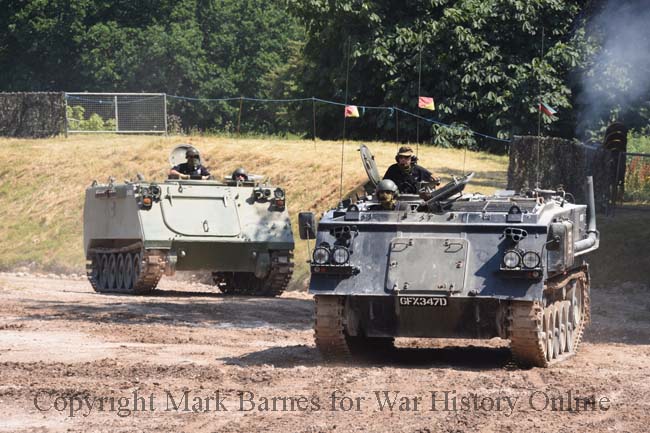
This shot affords us an opportunity to compare the British FV432 armored personnel carrier with a very similar M113 wearing Canadian markings. The 432 is the most common in a family of vehicles first introduced during the 1960s and a thousand or more remain in service with the British Army.
A good many of these have benefited from life extending programs and they will be around for some time to come. The vehicle has proved popular with enthusiasts because it is such an affordable example of tracked armor. The 432 is the basis of many conversions to build replicas of World War II era armor – notably examples of the StuG III and Japanese Type 97 and other surprises are in the offing.
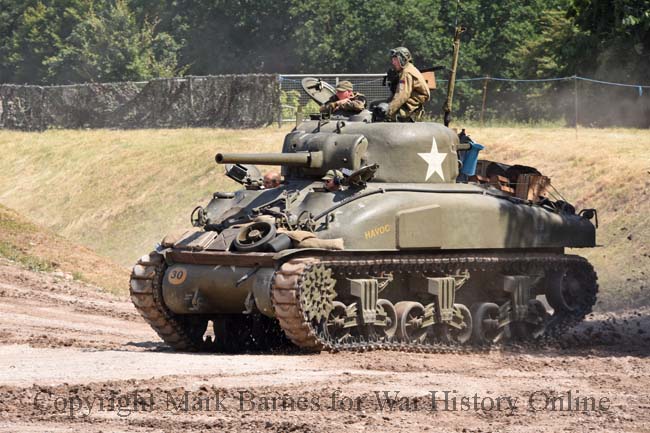
Chris Till’s M4A1 Sherman Havoc is a much-admired product of Lima, Ohio making regular appearances on the show scene in the United Kingdom. Chris’ M4 was a star of Armor & Embarkation in 2016 and is a firm favorite with the crowds at Bovington.
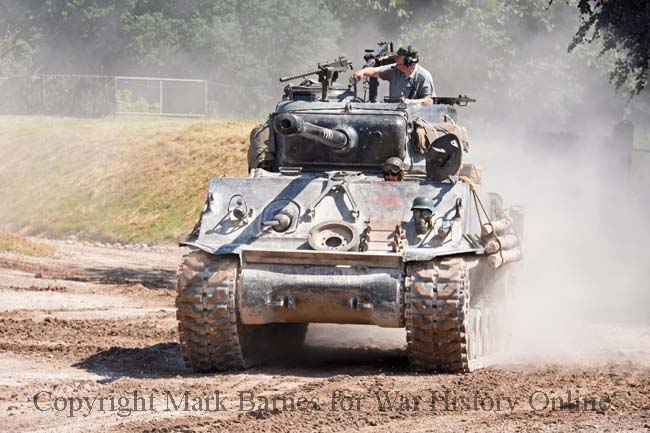
The Tank Museum’s M4A2E8 Sherman retains the look it has worn since its starring role in Fury, a movie that should need no introduction whatever your opinion of it. This tank is a very different animal compared to the M4A1 we saw previously.
Your correspondent feels it is now relatively safe for him to admit to spilling the best part of a gin and tonic over the tank during a lively evening at the Tank Museum back in 2016. The tank appeared to be the quickest of the four Shermans displayed this year, putting in an impressive performance.
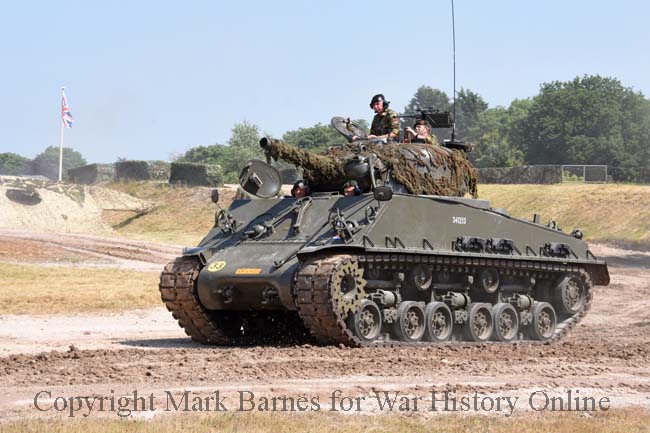
This smart looking M4A3 105mm Sherman dates from 1945 and was brought over to England by a team from the National Military Museum in the Netherlands. The tank uses the same HVSS suspension as Fury and your correspondent did not envy the guy standing on the engine deck holding on to the .50 calibre machine gun as it rumbled round the arena.
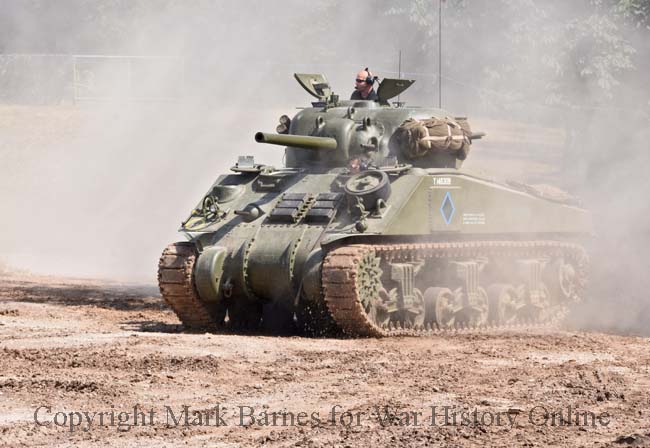
Adrian Barrell’s fantastic M4A4 Sherman ended its service life as a range target on Salisbury Plain; perhaps the British Army’s best known exercise area. It was pretty battered when rescued by Adrian in 1991 and the 4,000-hour restoration he carried out has been applauded as one of the finest there is.
The tank was built at the Detroit Tank Arsenal in 1942 and was issued to the US Army before being passed on to the British who designated the type as the Sherman V. I first photographed this tank over ten years ago and am always pleased to see it doing the rounds. Adrian described the restoration in a series of articles for War History Online that appeared back in 2014 and they are still available thanks to the magic of the internet.
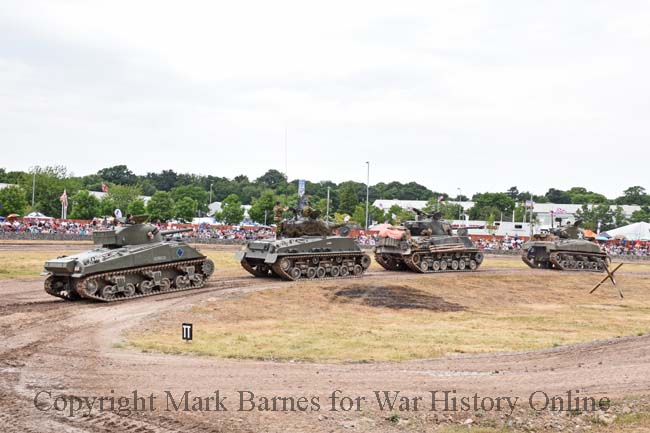
All four Shermans in a line-up taken on the Sunday after clouds intruded on proceedings although it remained very warm after two days of perfect sunshine at Bovington. How many shows can boast four Shermans in their line up?
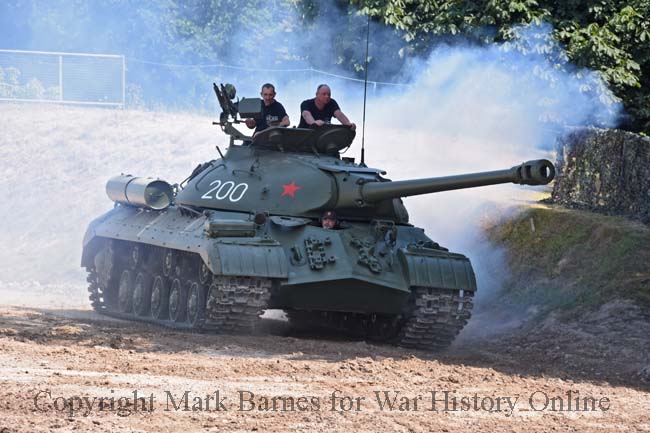
This stunning Russian IS-3 was the subject of a great deal of work by the team from the Royal Army Museum at Brussels, Belgium, to get it ready for its starring role at this year’s show. The tank is sometimes known as a JS-3 as a further simplification of the English translation of the name Josef Stalin.
The tank was an improvement on the IS-2 and was developed at Chelyabinsk, but unlike its predecessor it did not see service during the final weeks of World War II in Europe. The low silhouette and layout of the tank caused considerable surprise in the West when it was first seen at the victory parade held in Berlin in September 1945.
It is easy to trace the lineage of modern Russian tanks when admiring the IS-3. The tank was shrouded in a thick mist of blue smoke when it appeared at the rehearsal on Friday but it had settled down on the main show days.
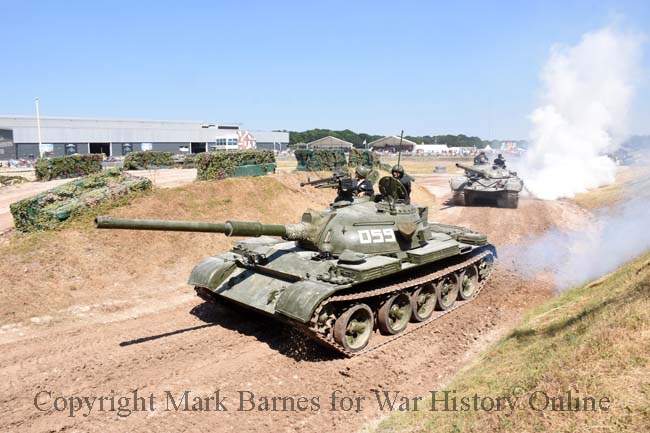
A Chinese Type 59 leads a T-72 in another fast paced sequence from the first full day of the show. Over 10,000 examples of the Type 59 were built in China and it was a great success on the export market. A large number were sold to Iraq during the rule of Saddam Hussein and a proportion of them found their way to the west following the wars fought in 1991 and 2003.
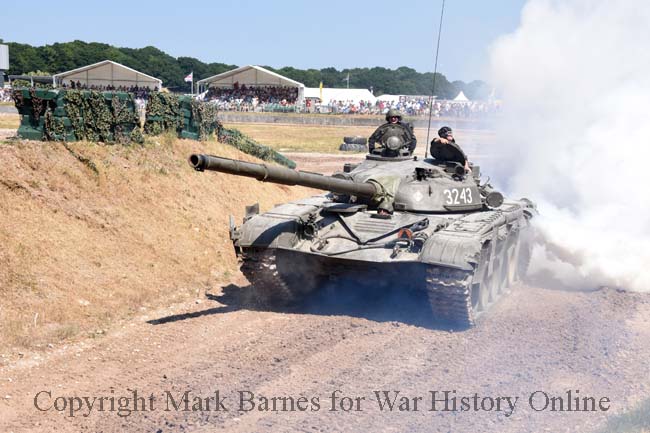
The T-72 is a firm favorite with the crowds at Bovington, especially when the crew perform their party trick of making a smoke screen that can really get going if it takes up half a lap of the arena. Once the tank passed the press area there was nothing to see for a good few minutes and all the photographers stank of fuel. Great fun!
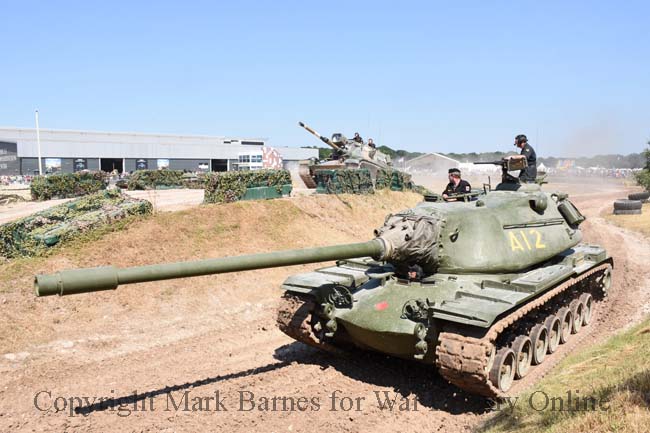
The pairing of an M60 and the imposing M103 is something to see. This M103A2 makes an occasional appearance in the show line up and the sheer size of the turret blows me away. This was the last heavy tank in US service before the concept of main battle tanks became the norm. The M103 went into service in 1958 and were withdrawn by 1974.
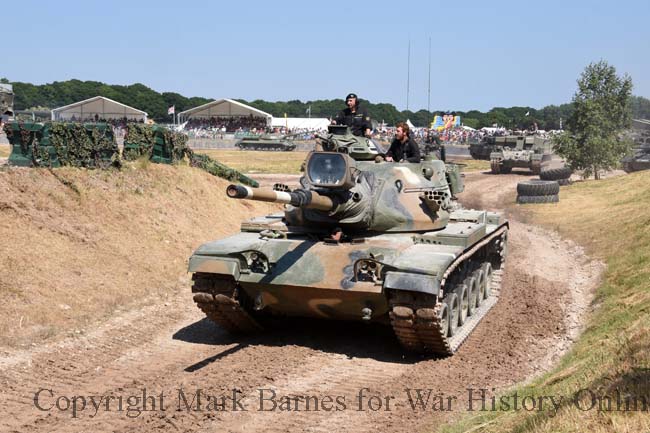
The M60 Patton main battle tank came along in 1960 and a large number were still going strong thirty years later. Over 15,000 were built and production did not cease until the 1980s. There have been one or two on the show scene in England over the years and they are always great to photograph.
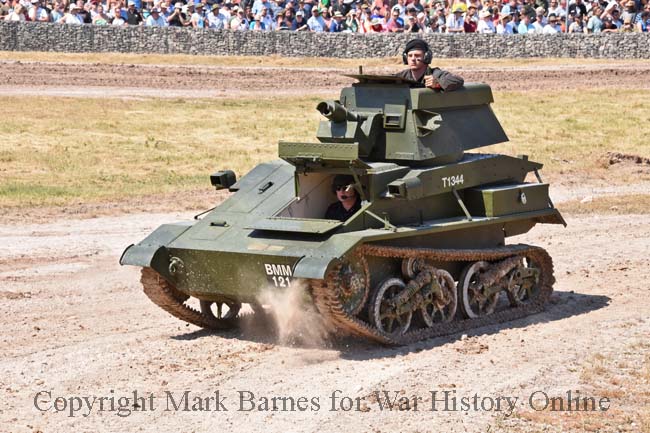
The British decision to go down the tankette route during the 1920s and 1930s can easily be seen as unfortunate. They were a cheap and plentiful option at a time when money was extremely tight and doctrine was under constant scrutiny. Hindsight tells us they were totally inadequate and the crews who took these Vickers Light MkIV tanks into battle against German armor and anti-tank weapons must surely be considered brave beyond question.
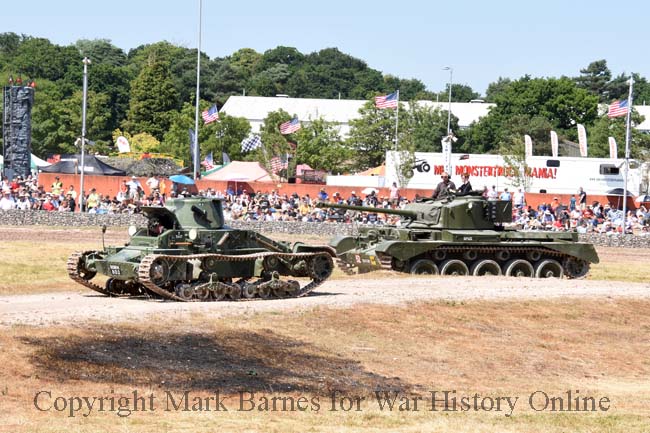
It’s hard to believe that there is less that less than a decade separates the introduction of the Infantry Tank MkI Matilda and the imposing presence of a Comet tank from 1945. The Matilda had sufficient armor to withstand German guns in 1940 but it was painfully slow and only armed with a machine gun.
This example was rebuilt from a range wreck and is the only runner left although there are another three at Bovington on static display including another heavily damaged range target. The Comet is a consistent crowd favorite. It bridges the gap between the British cruiser tanks of the 1930s and 1940s and the superior types that would serve through the Cold War.
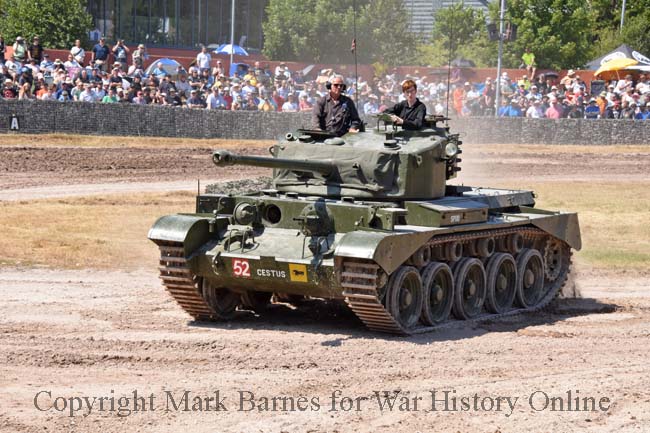
People continue to compare the Comet with the Sherman Firefly but there can be little doubt that it would have been preferable to have a tank of this quality in greater numbers before 1945. The 77mm gun is a shortened version of the 17 Pounder found in the Firefly and despite a lack of sloping armor that would be incorporated into the Centurion, the Comet proved to be fast and effective against German adversaries.
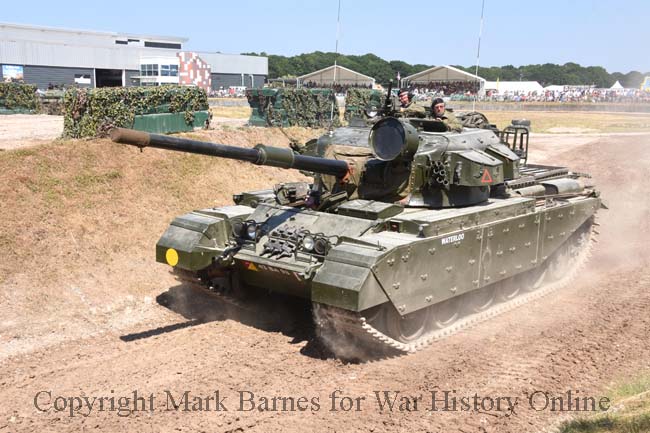
The Centurion, in this case a Mk12, was one of the most successful tanks to come out of lessons learned during World War II. The first model was just too late for the conflict but took part in the Korean War and went on to serve with the Australians in Vietnam and with a host of other countries including the Netherlands and Israel.
Specialized variants were still in British service during the 1991 Gulf War. The durability of the Centurion is never in doubt although the tank on show at Bovington proved to be a little more troublesome.
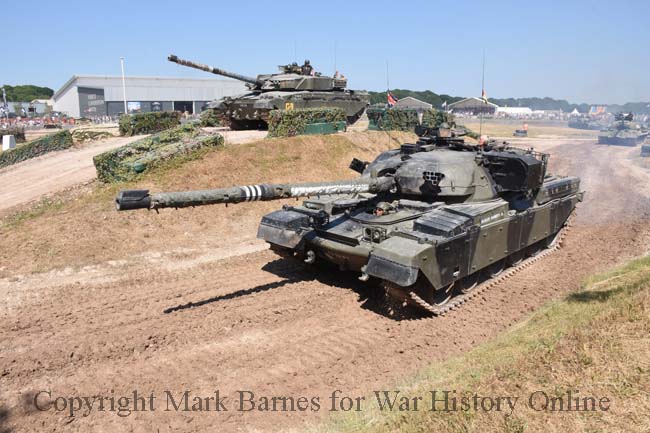
This shot is helpful for showing a Chieftain Mk10 (nearest the camera) and a Challenger 1. Both these tanks provided sterling service for the British Army from the Cold War through to the 1991 Gulf War, although the Chieftain never fully dodged problems with reliability.
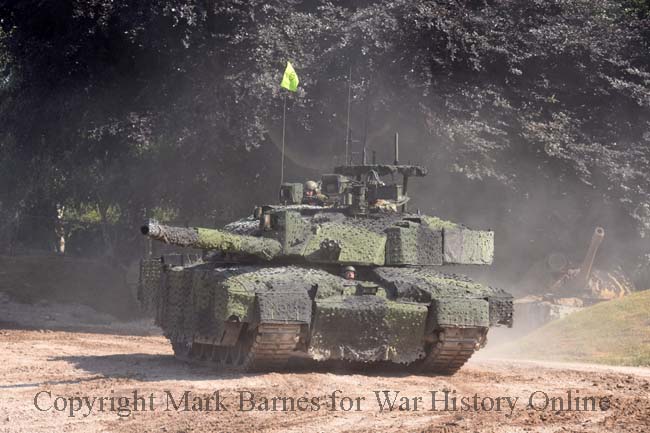
The stunning Challenger 2 remains in British service and is the subject of a lengthy life extension program to see it continuing in operation well into the next decade. Like its predecessors, the Chally 2 was the product of the late lamented former Vickers works at Elswick in the north-east of England.
With the loss of this manufacturing skill base it has to be wondered where a new British designed tank will come from, if at all, in an age of international partnerships formed to share development and production costs.
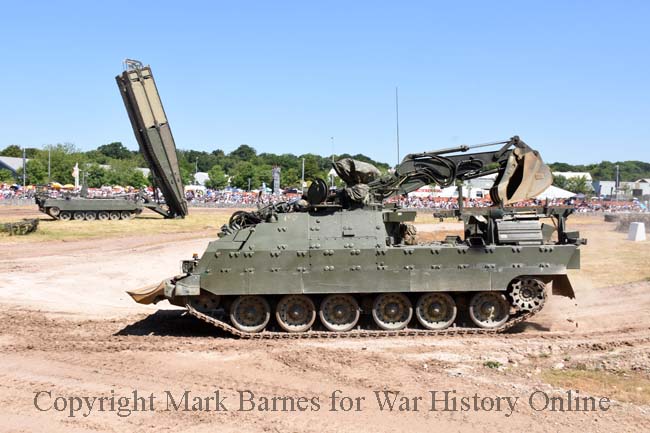
Specialized variants of the Challenger are a vital part of the British Army’s inventory. The Titan AVLB bridge layer and the Trojan AVRE put on an impressive display for the Bovington crowd accompanied by several other types. Fair to say it is the big stuff that always leaves a great impression and these two did not disappoint.
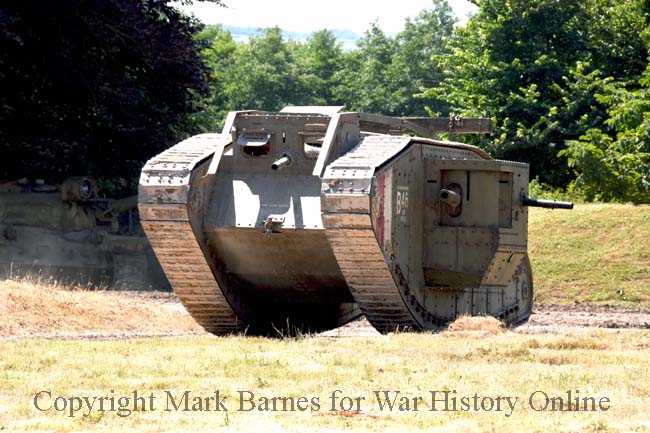
Tankfest wouldn’t be the same without an appearance from the type of rhomboid shaped tank that started the ball rolling. This MkIV Male replica was built for Steven Spielberg’s film adaptation of War Horse after which it became part of the running fleet at Bovington.
None of the museum’s original Great War era tanks are considered to be in a solid enough condition to run these days and this impressive film prop makes for an ideal substitute.
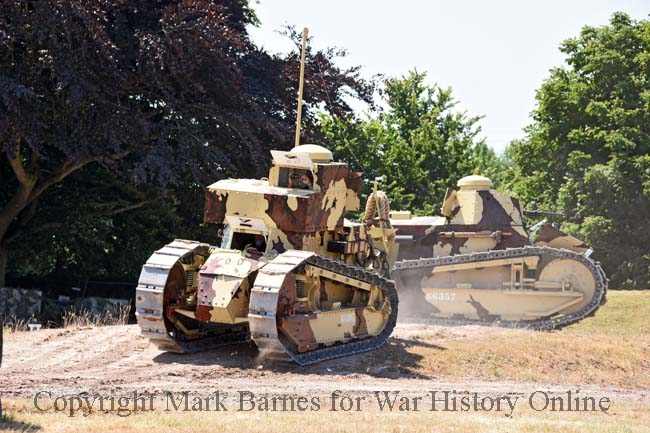
I was genuinely excited when I learned the Weald Foundation’s pair of Great War era Renaults would attend this year’s show and they did not disappoint. Both restorations were only completed a short time before the show and the team responsible for these amazing little vehicles must be both thrilled with their handiwork and proud of the admiration they have received.
The Renault FT has a deserved place in history thanks to its influential layout, although the very first tank, Little Willie, which can be seen at Bovington, was intended to have a turret but weight issues could not be resolved.
This takes nothing away from the FT, surely one of the most iconic designs of its era. The TSF radio tank was only built in small numbers, seeing service for some time after the Great War. The Weald Foundation has something very special on their hands with these two wonderful restorations.
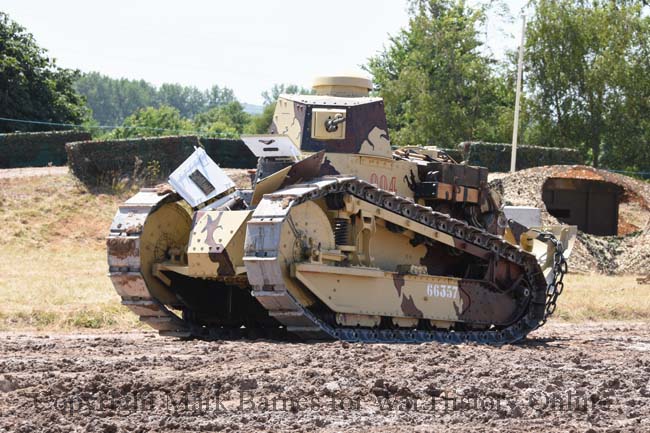
The Renault FT would spawn a number of copies, notably those built in the United States and Italy. The FT stayed on in French service well into the 1930s and has the distinction of being the only tank to see combat during the Great War and World War II.
US forces discovered a number of them in Afghanistan and these are the subject of restoration projects. The French were adventurous with their camouflage schemes and there is no question the pattern chosen by the Weald Foundation was effective because the tanks virtually disappeared when I tried to snap them with the crowd in the background. A rapid change of positions proved essential.
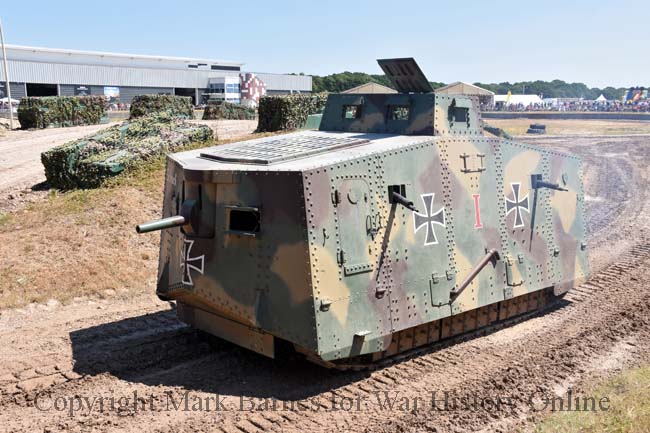
This replica A7V completes the Great War billing at this year’s show. Like the others, Schnuk ambles along at a sedate pace and the event timetable dictates that they occupy the slot before the lunch break so they can get out of the arena before the faster stuff gets going.
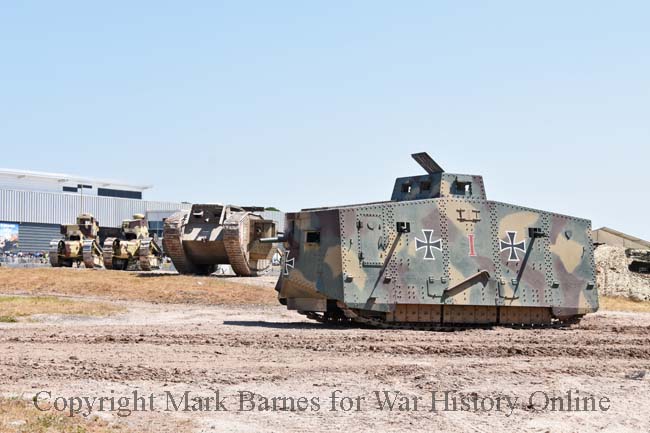
Tankfest boasted a classic line up of Great War tanks at this year’s event. The Weald Foundation’s Renault TSF and FT joined the Tank Museum’s MkIV Male replica and the impressive A7V replica Schnuk. Even after a couple of decades snapping armor on a professional basis it is moments like this that continue to make the job a privilege.
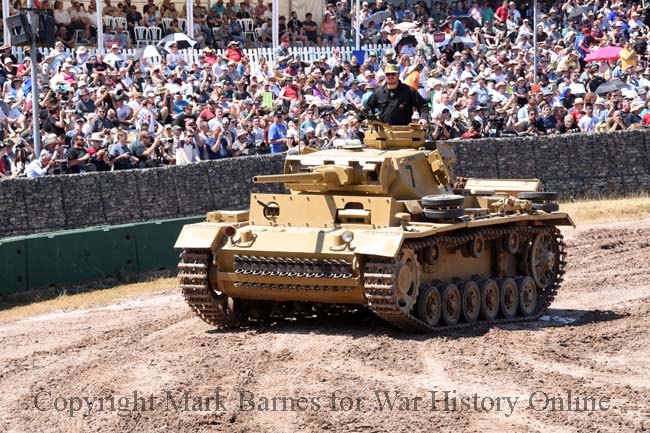
The Tank Museum’s Panzer III was captured during the North African campaign and made its way to Britain for a thorough examination before finding its way into preservation. This tank is a favorite with the crowd and the hot sunny weather really brought out the color scheme in my photographs.
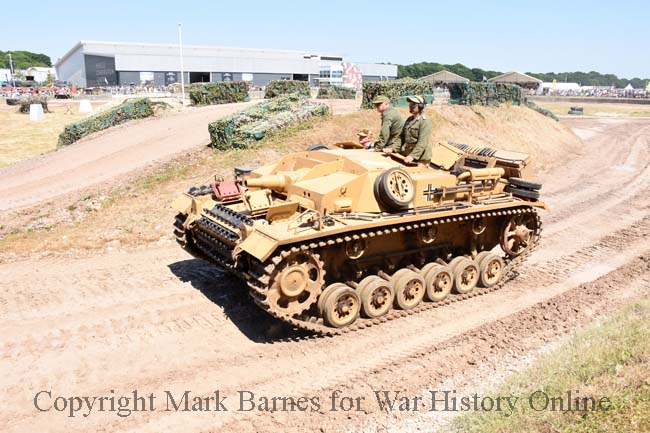
Jon Phillips’ stunning Sturmgeschutz III Ausf D was the subject of a lengthy restoration a great many people followed on social media. It’s fair to say Jon was grateful for the huge amount of support he received, especially from people offering parts for what is a rare variant of the StuG.
The restoration highlighted just how different the various models were and this underlines how the German failure to standardize had such a damaging impact on their production effort, especially when we consider how many tanks and other armored vehicles they managed to build regardless.
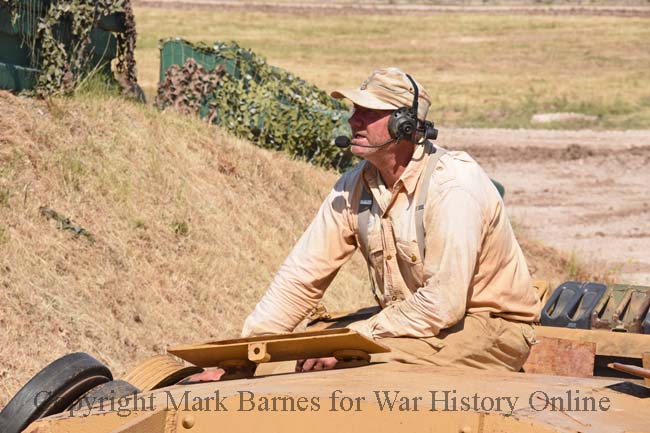
Here is Jon Phillips soaking up the rays as his StuG rumbles around the arena. Jon also brought along his excellent Marder III restoration but it only made a brief foray into the arena and didn’t do a full lap for me to get a decent snap. Maybe next year?
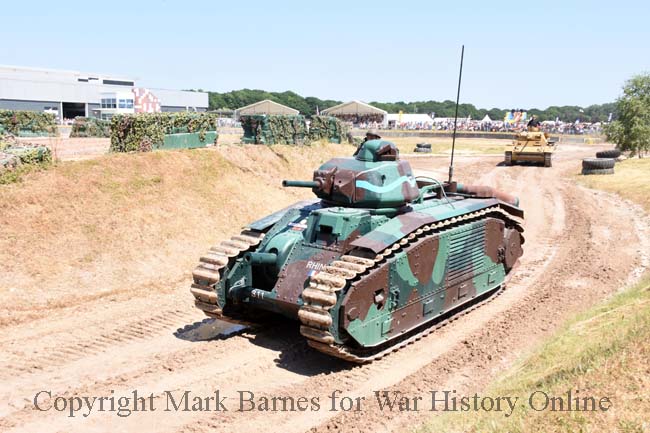
For me the star of this year’s event was the Renault Char B1bis of 1938. This is a magnificent looking tank, the embodiment of all our perceptions of between the wars armor. The tank was brought over from the museum at Saumur in France and this follows on from the much-appreciated appearance of the Great War period St Chamond at last year’s event.
That the people at Saumur are prepared to take their rare runners on the road to Bovington shows a spirit of cooperation to be admired and the same can be said of the museums in Belgium and the Netherlands who brought their tanks to Dorset.
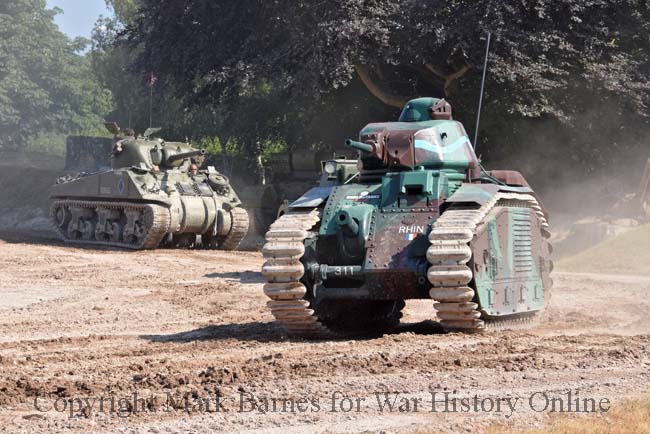
The finale of the event gives the public a wealth of different tanks and armored vehicles rumbling around the arena. How often do you get the opportunity to photograph a Char B and a Sherman together?
The appearance of the Char B, the Great War Renaults and the IS-3 underline the pulling power of Tankfest. Getting decent photographs can sometimes be a challenge at the venue, but the fact remains the warm feel of the event and the special nature of the armor on view makes it a unique occasion every time. Roll on 2019!
